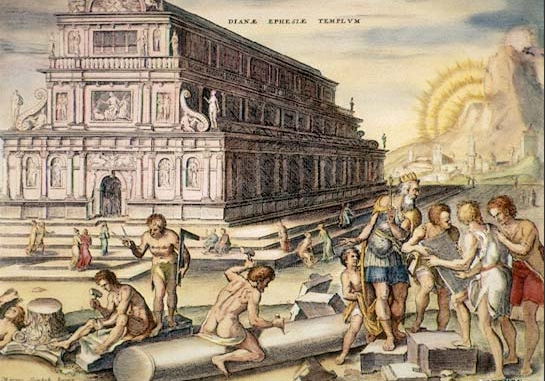*Image Credit: Wikimedia Commons The Seven Wonders of the Ancient World defy modern understanding. Massive structures built by “primitive” technologies, one of the group – the Temple of Artemis in Ephesus – fell victim to arson shortly after its completion on July 21, 356 BCE. This second iteration of the famous temple, having been worked on for nearly two centuries, would eventually be replaced by a larger project some three decades later. The original temple, according to some sources, dated to the 8th Century BCE. Believed to be the oldest structure of its kind in Asia Minor, the first Temple of Artemis was buried under as much as 15 feet of silt during flooding between the 700s and 500s BCE. The second version would do more than just replace the first, it would rise above Ephesus to become one of the iconic buildings anywhere in the known world. Croesus, the Lydian king and overlord of Ephesus, is said to have initiated the new design around 550 BCE – just a few years before the Persians would conquer the region. Known to history as a man of large wealth, Croesus is said to have funded a portion of the design and construction out of his own pocket, bringing the architect Chersiphon and his son Metagenes over from Crete to manage the undertaking. According to legend, the materials list included a particular stone for the first time: marble. The design, 377 feet in length and 151 feet wide, featured 36 columns. The ceiling stretched 40 feet overhead, inspiring awe in adherents who ventured into the cella – home to the image of Artemis, the goddess of the hunt. According to the Roman historian Pliny the Elder, a black statue stood at the center of the altar, with an opening above the chamber to allow smoke from sacrifices to rise up to and entreat Artemis herself for favor. While under construction, the temple became an major tourist attraction for the Ephesians. Due to Artemis’ position as a goddess of provision, merchants found her an important deity to have on their side. Leaving gifts of jewelry and other valuables, businessmen and kings sought her help to increase their financial security – perhaps to match up with that of the legendary Croesus, if she saw fit. After nearly two centuries of work, the Temple of Artemis stood finished – a landmark achievement for the Greeks of the day. Though historians are unable to place the exact date of its completion, most agree the fire that burned it to the ground on July 21, 356 BCE was started shortly after the project came to an end. A young man desiring to have a name that lasted through the ages, Herostratus, lit one of the roof beams on fire. Proud of his achievement, he immediately proclaimed his guilt. In addition to having him executed, the Ephesians attempted to prevent further fame-seeking by forbidding his name to be spoken, threatening those who did with death. (Theopompus, a historian of the era, managed to avoid punishment for writing it down.) In 323 BCE, a reconstruction project began, funded by the people of Ephesus. Alexander the Great, moving through on his way to conquering the Persians, had offered to rebuild the temple but the townspeople brushed him aside – perhaps in part angered by the belief Artemis had been unable to protect the structure due to her supposed attendance at the king’s birth. The third and final edition would be 25 percent longer (450 feet) and 50 percent wider (225 feet) than the second – lasting until the Goths raided the region in 268 CE before having some of its remains used in a stunning religious structure that exists to this day: Hagia Sophia in Istanbul.
July 21, 356 BCE – The Temple of Artemis Burns to the Ground in Ephesus
*Image Credit: Wikimedia Commons The Seven Wonders of the Ancient World defy modern understanding. Massive structures built by “primitive” technologies, one of the group – the Temple of Artemis in…
170
